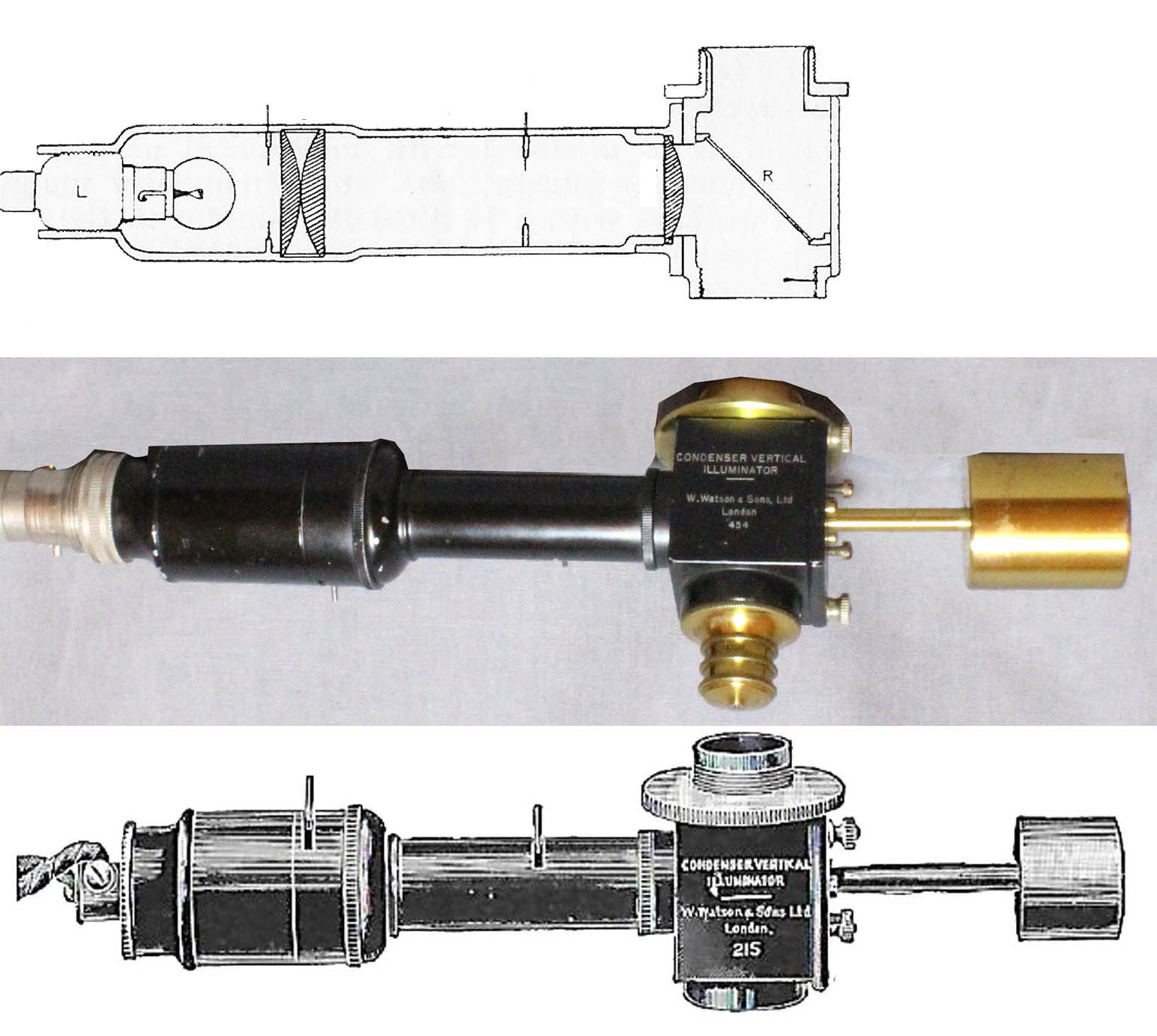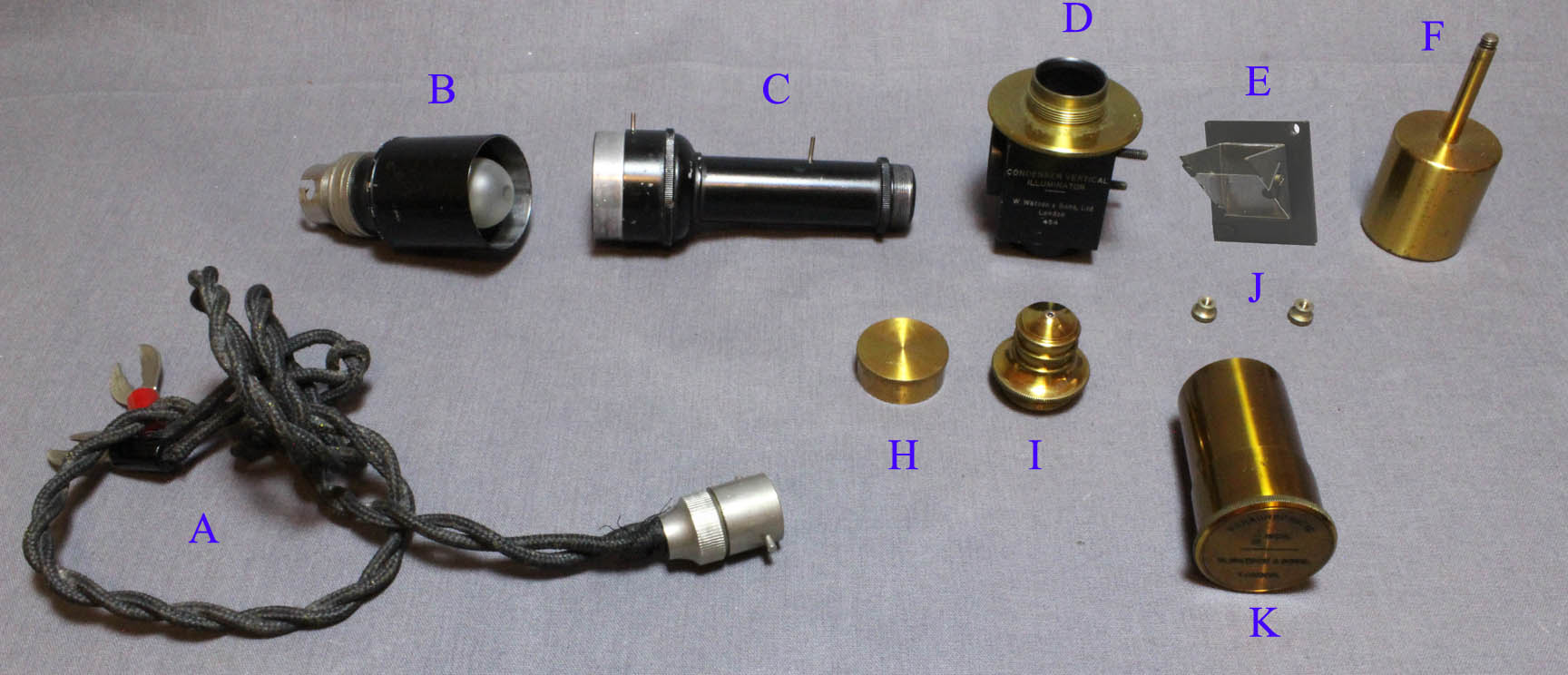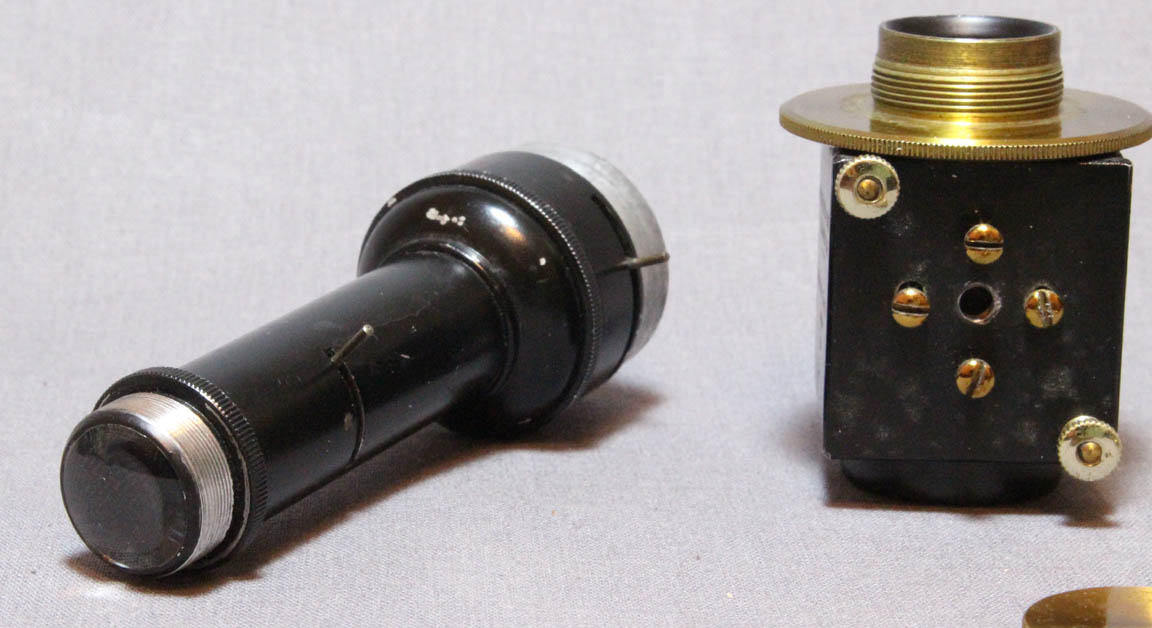MICROSCOPE-ANTIQUES.COM © 2013-18.
GRAND VAN HEURCK MICROSCOPE (Watson-Conrady Vertical Illuminator)
c.
Maker: W. WATSON & SONS LTD.


DESCRIPTION:
 The instrument screws onto the nosepiece and an objective(I) designed for objects not covered by a coverslip is screwed on the bottom of the illuminator underneath the reflector housing(D).
The illuminator has a standard type coverslip which serves as the reflector. The housing for the coverslip(E) can easily be removed, and the angle of orientation of the coverslip can be adjusted by screws. Instead of light being directed from a separate system away from the microscope, this instrument provides a system in which an electric light bulb(B) is integrated into the instrument. Furthermore the light travels in the part of the instrument with optics(C) through two iris diaphragms and condenser lenses providing easily regulated illumination. A is the electric cord attached to the light fixture by a bayonet connection, F is a counterweight, H is a dustcap for the top of the instrument when not attached to the microscope, I is the special metallurgical objective, J are the two screws holding the reflector in place, and K the can to house the objective if off the instrument. Since the light source is integrated into the device, focusing the tube main tube of the microscope does not interfere with steady illumination, as it would with an ordinary vertical illuminator; this is why dedicated metallurgical microscopes have stage focusing rather than tube focusing; this does not matter when using the Watson-Conrady Illuminator.
The instrument screws onto the nosepiece and an objective(I) designed for objects not covered by a coverslip is screwed on the bottom of the illuminator underneath the reflector housing(D).
The illuminator has a standard type coverslip which serves as the reflector. The housing for the coverslip(E) can easily be removed, and the angle of orientation of the coverslip can be adjusted by screws. Instead of light being directed from a separate system away from the microscope, this instrument provides a system in which an electric light bulb(B) is integrated into the instrument. Furthermore the light travels in the part of the instrument with optics(C) through two iris diaphragms and condenser lenses providing easily regulated illumination. A is the electric cord attached to the light fixture by a bayonet connection, F is a counterweight, H is a dustcap for the top of the instrument when not attached to the microscope, I is the special metallurgical objective, J are the two screws holding the reflector in place, and K the can to house the objective if off the instrument. Since the light source is integrated into the device, focusing the tube main tube of the microscope does not interfere with steady illumination, as it would with an ordinary vertical illuminator; this is why dedicated metallurgical microscopes have stage focusing rather than tube focusing; this does not matter when using the Watson-Conrady Illuminator.
HISTORY of the WATSON-CONRADY ILLUMINATOR:
The 'Watson-Conrady Vertical Illuminator' with built-in light source, was made from about 1923 through the 1940's. It could be powered by a battery, or with house current, with a resistance device. In addition to a lens system, it had two iris diaphragms making Kohler illumination possible. Furthermore, because the light source was intrinsic to the illuminator, it could be used with a tube-focusing microscope without the annoyance of having to move the light source to adjust for changes in focus or objective. This set the standard for modern vertical illuminators, providing Kohler illumination in the vertical illumination configuration.
HISTORY OF EPISCOPIC ILLUMINATION
For the history of vertical illuminators and episcopic illumination please see the Episcopic and Vertical illuminator page.


 The instrument screws onto the nosepiece and an objective(I) designed for objects not covered by a coverslip is screwed on the bottom of the illuminator underneath the reflector housing(D).
The illuminator has a standard type coverslip which serves as the reflector. The housing for the coverslip(E) can easily be removed, and the angle of orientation of the coverslip can be adjusted by screws. Instead of light being directed from a separate system away from the microscope, this instrument provides a system in which an electric light bulb(B) is integrated into the instrument. Furthermore the light travels in the part of the instrument with optics(C) through two iris diaphragms and condenser lenses providing easily regulated illumination. A is the electric cord attached to the light fixture by a bayonet connection, F is a counterweight, H is a dustcap for the top of the instrument when not attached to the microscope, I is the special metallurgical objective, J are the two screws holding the reflector in place, and K the can to house the objective if off the instrument. Since the light source is integrated into the device, focusing the tube main tube of the microscope does not interfere with steady illumination, as it would with an ordinary vertical illuminator; this is why dedicated metallurgical microscopes have stage focusing rather than tube focusing; this does not matter when using the Watson-Conrady Illuminator.
The instrument screws onto the nosepiece and an objective(I) designed for objects not covered by a coverslip is screwed on the bottom of the illuminator underneath the reflector housing(D).
The illuminator has a standard type coverslip which serves as the reflector. The housing for the coverslip(E) can easily be removed, and the angle of orientation of the coverslip can be adjusted by screws. Instead of light being directed from a separate system away from the microscope, this instrument provides a system in which an electric light bulb(B) is integrated into the instrument. Furthermore the light travels in the part of the instrument with optics(C) through two iris diaphragms and condenser lenses providing easily regulated illumination. A is the electric cord attached to the light fixture by a bayonet connection, F is a counterweight, H is a dustcap for the top of the instrument when not attached to the microscope, I is the special metallurgical objective, J are the two screws holding the reflector in place, and K the can to house the objective if off the instrument. Since the light source is integrated into the device, focusing the tube main tube of the microscope does not interfere with steady illumination, as it would with an ordinary vertical illuminator; this is why dedicated metallurgical microscopes have stage focusing rather than tube focusing; this does not matter when using the Watson-Conrady Illuminator.